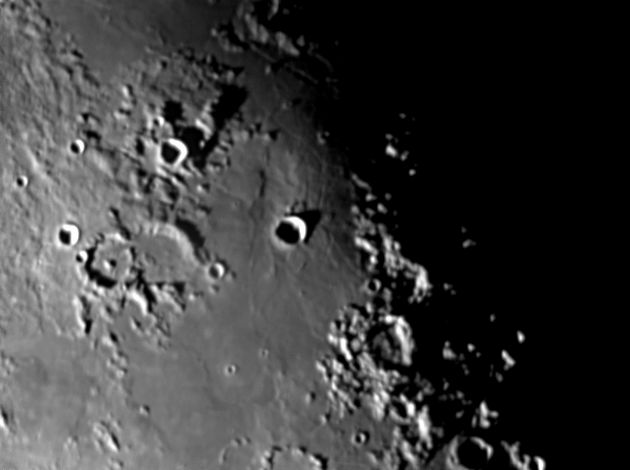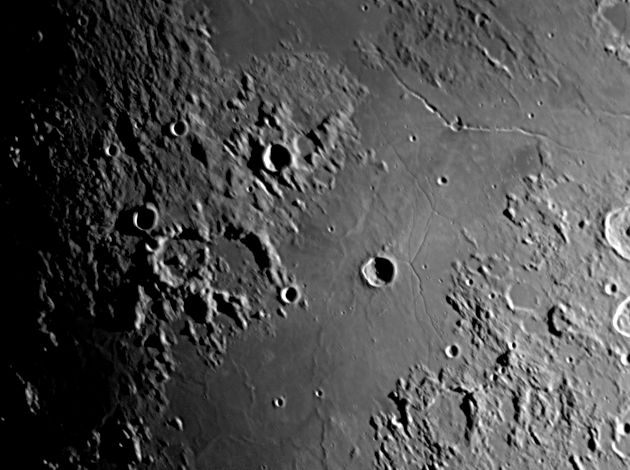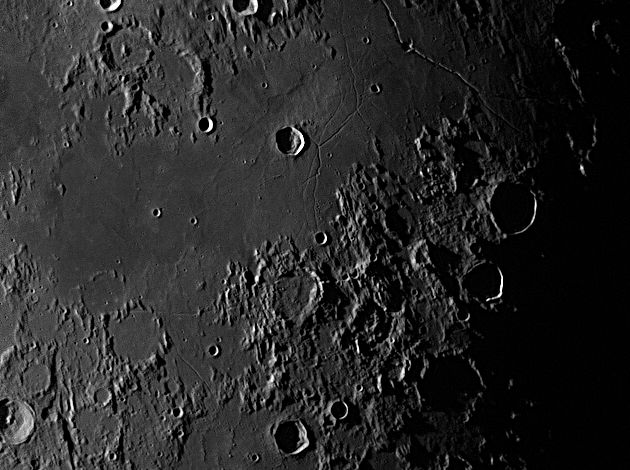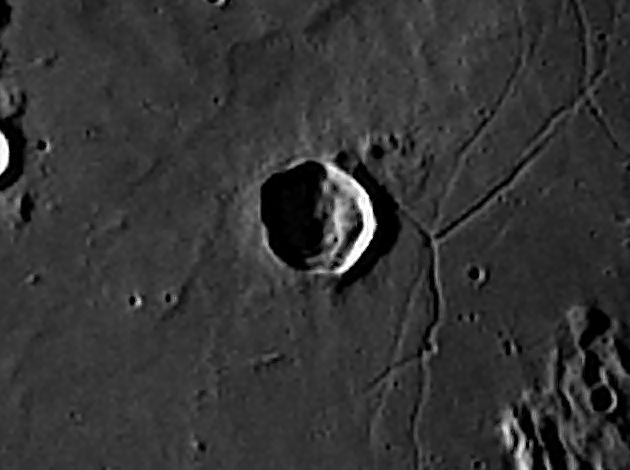Triesnecker and Sinus Medii 
Move your mouse over the picture to see the names of some of the features.
Sinus Medii is so called because, when the Moon is in its mean position librationwise, it is in the middle of the visible face. Consequently the equator and the prime meridian pass through it and my mouseover of the first image shows where they run.
Triesnecker, at 27 Km in diameter, is a typical example of complex crater in the range of 10 to 35 Km. For such craters, the rocks at the bottom of the inner wall are not strong enough to support the overlying rock and the walls collapse into the crater. This results in a crater whose depth, relative to the diameter, is less than for smaller craters. In addition, the compression of the rocks by the larger missile causes a rebound which gives rise to a central mountain.

|
Sadly, neither of the features of complex craters is visible in this image of Triesnecker as the Sun was too low in the lunar sky to illuminate the inside of the crater. The features are, however, visible in the much older (and larger) craters, Pallas and Rhaeticus.
The picture was taken with an Atik camera attached to my LX200 on 12th December 2006 when the Moon was 21.7 days old.
Lunar Phase: 274.1°
Colongitude: 173.2°
Date and Time: 12 December 2006 05:44 UT
Camera: Atik 1-HS
Telescope: LX200
Capture: K3CCDTools. High gamma, 1/100", 12% gain, 506 frames
Processing: Registax. 8 alignment points, 468 frames stacked. Wavelet 1-2 = 10, histogram 10-185 |

|
And here the same area imaged with the light coming from the east. The sun was somewhat higher so we can see into Triesnecker. Although the central mountain is still not visible, the terraced western wall can be made out. There are many rilles in this area some of which stand out in this picture. Rima Hyginus is 226 Km long and about 3 Km wide. The Triesnecker rilles are a complex series of narrow cracks which are not well resolved here.
The scale markers represent approximately 100 Km north and east.
The picture was taken with an Atik camera attached to my LX200 on 26th March 2007 when the Moon was 8.4 days old.
Lunar Phase: 78.9°
Colongitude: 5.9°
Date and Time: 26 March 2007 20:11 UT
Camera: Atik 1-HS
Telescope: LX200
Capture: K3CCDTools. High gamma, 1/100", 19% gain, 462 frames
Processing: Registax. 12 alignment points, 417 frames stacked. Wavelet 1-2 = 10, gamma 1.2, histogram 0-200 |

|
And here the same general area imaged with the light coming from the west but with a higher Sun than in the top picture here. We can see into Triesnecker and see the other half of the floor of this crater compared to the picture above. The Triesnecker rilles are a complex series of narrow cracks and are much better resolved in this image.
The scale markers represent approximately 100 Km north and west.
The picture was taken with a DMK camera attached to my LX200 on 31st August 2010 when the Moon was 20.7 days old.
Lunar Phase: 288.3°
Colongitude: 168.4°
Date and Time: 31 April 2010 04:44 UT
Camera: DMK 21AF04
Telescope: LX200
Capture: ICCapture. 1/108", gain 716, 3070 frames
Processing: Registax. 100 frames stacked. Wavelets 1-2 = 10, gamma 1.2, Focus Magic 1,100 |

|
This is a 4-times enlargement of the picture above, centred on Triesnecker and the mouseover shows an 8-fold enlargement. Each enlargement was done, in PhotoImpact, in steps of times-2 followed by some sharpening using Focus Magic. Looking carefully at either image reveals some detail in the shadowed part of the floor of the crater. I don't think this is an artifact of processing and enlargement, so may be the result of light reflected into the shadow from the fully-lit eastern rim. This effect has been noticed before.
Lunar Phase: 288.3°
Colongitude: 168.4°
Date and Time: 31 April 2010 04:44 UT
Camera: DMK 21AF04
Telescope: LX200
Capture: ICCapture. 1/108", gain 716, 3070 frames
Processing: Registax. 100 frames stacked. Wavelets 1-2 = 10, gamma 1.2, Focus Magic 1,100
Photoimpact. Enlargement and Focus Magic |
Home Back to Lunar Index

